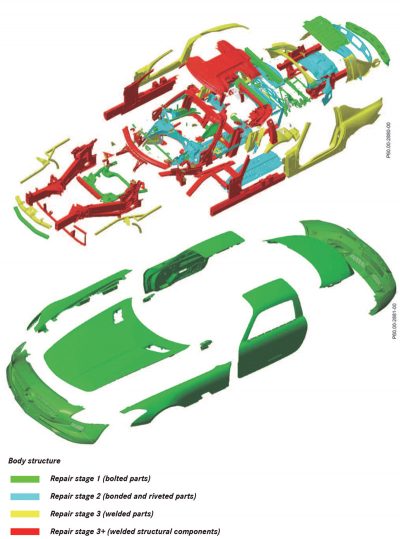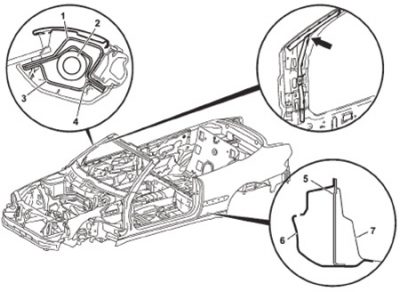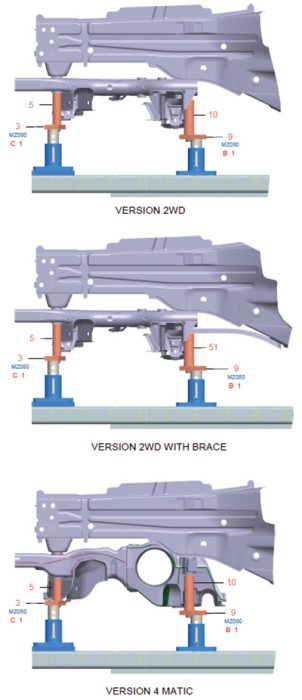Tape measures and levels are ancient history. Today, you need the right equipment and procedures to put things back where they need to be EXACTLY.

Mercedes-Benz requires vehicles needing structural restoration to be repaired on a straightening bench that is dedicated to the specific model and approved by the company. Examples of structural areas include any that involve axle mounting points, damage to longitudinal members (frame rails), floor cross-support beams, A, B, and C-Pillars, and side reinforcements.
Stable anchoring system
A dedicated straightening bench features jigs that function as both a stable anchoring system and a precision reference point. Jigs hold the vehicle in place and the target component stable while you disassemble down to a location where you will section, or to a part from which you will build back out. They allow you to disassemble damaged components while avoiding further destruction of any portion that you need to salvage. Once attached, jigs permit you to cut, pull and straighten a component without altering the position of adjacent undamaged parts.
Factory reference point
Mercedes-Benz partners with collision repair bench manufacturers to develop straightening equipment and jig sets that are dedicated to one Mercedes-Benz vehicle model. These jig kits are designed to fit key structural anchoring points and components for an individual Mercedes-Benz platform with zero tolerance. When used properly, they allow you to restore the damaged area to factory dimensions.
You attach jigs to beams that mount laterally across the bench. Refer to the vehicle data sheet to determine cross beam and jig positions. Using the correct data sheet ensures that all control (anchor) points and pulls as you proceed are specific to the vehicle you are repairing.
Once in place, beams and jigs provide a three-dimensional anchoring system that verifies whether or not key locations match their factory reference dimensions. And the jigs bolt to the reference locations so control points do not shift as you make pulls.
Reduced need to measure
A dedicated straightening bench with three-dimensional anchoring jigs allows the technician to know when a component or point is in its correct position without having to measure. The magic of a dedicated straightening bench is that a jig in its proper data sheet location will only point to or mate correctly with a component when the damaged area has been restored to its factory specified position. Until you pull the damaged area to the position that is correct in three dimensions (length, width and height), the component will not fully meet the jig.
Set anchor points in undamaged areas
Your first mounting locations must be points not affected by collision damage. You then straighten one small amount of damage and either install the replacement component or place additional jigs related to that now-corrected area.
You pull in small increments. You often can see on the work if you miss a target, but the software offers precision beyond what the eye can see. On-screen results alert you when there is zero difference between the desired and the actual location of the pulled point. With a little practice, you’ll get to where you confidently pull without overshooting the target.
Zero tolerance precision
Once you complete a pull for a component or location, that result becomes an anchoring point for additional pulls. You continue this process until you can begin replacing or repairing components. Your repairs are based on zero-tolerance precision without introducing the risk of measuring error. The complicated math involved in locating a position in three dimensions is handled by the software and verified on screen in real time as you conduct the pull. Elimination of the potential for measuring error is the reason Mercedes-Benz does not publish body dimension data, and does not approve the use of comparative measurements of known-good components or vehicles to determine collision repair location points.
A dedicated fixture bench with three-dimensional anchoring jigs takes a little longer to set up, but it makes up for it in the precision offered by its zero-tolerance location of points. It also saves time on the back end by not having to measure each pull in multiple dimensions. Even laser and sonic measuring systems, although semi-automated, are not faster than not having to measure at all.
Sedan, Coupe, Cabriolet…
A dedicated straightening bench is set up differently for each vehicle model or platform, for what areas sustained damage, and for the level of vehicle disassembly at the start of structural repair. Which jigs are mounted on the bench is dependent upon the mix of these variables.
For example, the 2005 to 2012 Mercedes-Benz A-Class hatchback (model 169.0) uses a different jig setup from the 2005 to 2008 B-Class 5-door hatchback (model 245.2).
Jigs and component location

A comparison of differences between key structural parts on a CLK Cabriolet versus the CLK Coupe gives an example of how the jig setup of a dedicated bench simplifies component placement issues that could be subject to human error if done manually. The body of the CLK Cabriolet (model 208.4) is essentially based on the floor, front end, and rear assemblies of the CLK Coupe (model 208.3). Despite this shared platform base, panel thicknesses of structural parts such as the longitudinal members, A- and B-Pillars are larger for the CLK Cabriolet (convertible) than for the CLK Coupe. The panel thicknesses create point-to-point measurement differences that, although not easily discernible to the eye, result in different jig locations on a dedicated bench. You must also adjust component placement to accommodate the related weld joint thickness variation. For structural repairs, you must mount these vehicles on a Mercedes-Benz-approved dedicated straightening bench.
Vehicle configuration differences

A dedicated straightening bench accommodates some structural differences based on vehicle configuration options. An example is the anchoring jig for the engine cradle on the two-wheel drive C-Class (W205). One version of the 2WD features a brace that supports the rear of the engine cradle through an additional connection to the longitudinal member. There is a different anchoring piece for the 2WD cradle with a brace than for the cradle version that has no brace (Celette jig set number 7205.5C).

Jig sets can also be set up differently to mount a vehicle with or without mechanical components (engine, drivetrain) installed.
Mercedes-Benz, Celette & Car Bench
Mercedes-Benz develops its repair procedures before a new vehicle is put into production. It crashes multiple cars, rebuilds them using different methods each time, then selects from among those results the repair procedures that offer a level of structural integrity equal to that of factory specifications.
Mercedes-Benz works with two straightening bench manufacturers — Celette and Car Bench — to jointly develop straightening benches and dedicated jig sets for each new model. Both offer dedicated jig systems for individual Mercedes-Benz models.
Do not use pinch welds or jacking points
Engineers combine information about the straightening requirements of different structural materials with what they learned from post-collision repair testing and use the results to select potential anchor points around the vehicle structure. The vehicle data card identifies as potential anchor points only those connections that have been proven able to absorb the pulling force needed to straighten the attached components or materials. A correctly located body point is bolted to the jig while you straighten, weld, or glue.
Mercedes-Benz explicitly states that floor pan pinch welds and rocker panel jacking points cannot be used to anchor the vehicle for structural repairs. When straightening structural components, the vehicle may work loose or warp if clamped at pinch welds or jacking points, which are not designed for sustaining maximum force. Straightening systems that rely on pinch welds or rocker panel jacking points may be used only for damage diagnosis, never for structural component repair.
Certified Collision Repair Facilities
Mercedes-Benz Certified Collision Repair Facilities must use Mercedes-Benz approved dedicated straightening equipment and fixtures, and are required to follow the company’s procedural instructions to perform structural repairs. Failure to do so may result in decertification of the repair facility.
Motivational speakers say that dedication is critical to life success. Mercedes-Benz engineers say that a dedicated straightening bench is a prerequisite for structural repair effectiveness. Both are correct.
Download PDF 〉





0 Comments